|
|
| SNOW LEOPARD CONSERVATION PROJECT ANNOUNCED Once again, the Cat Survival Trust has achieved real progress towards the continued survival of endangered cats in the wild.
After years of planning, which culminated last month in a visit to the Northeastern Indian state of Sikkim, the chance to set up a captive breeding and release programme has now become a real probability.
There is still much to do, but initial talks centering around ex-situ conservation involving establishing a breeding facility at the 230ha Himalayan Zoological Park, Bulbulay, just outside the capital Gangtok, have been very enthusiastically received by the authorities in Sikkim. Subsequent release in the wild will naturally be subject to extensive field research across the region to identify suitable sites, availability of prey species and exisiting populations, and this will be commissioned in the intervening years between now and when the first litter is ready for release.
Exciting times for your Trust, and an enormous thank you to everyone for your support in making this happen,
Dr. Terry Moore, Hon. Director. The Cat Survival Trust |
|
|
|
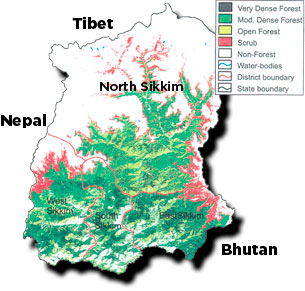
Why Sikkim?
Sikkim is a small, mountainous state in Northeast India which borders Nepal to the West, Bhutan to the East and Tibet Autonomous Region (TAR) to the North and Northeast. It was an isolated Himalayan kingdom until 1975 when Sikkim became part of India.
The very fact that a large chunk of Sikkim is above 4500m, where snow leopard are normally found is a necessary prerequisite, but what has particularly stirred our imagination is precisely how much of this habitat - nearly a third - is conserved by a network of wildlife sanctuaries and national parks, and where the trees are able to grow (below 4000m), an estimated 82% of the geographical area is reserve and protected forest where several species of cat, such as common leopard, Pallas' cat, clouded leopard, golden cat, lynx, leopard cat and marbled cat have all been recorded.
|
|
Meetings and More Meetings
With so much at stake it is essential to involve all the right people from the start and our first port of call was the Forests, Environment and Wildlife Management Department, Government of Sikkim. After all, they are the people who will have the final say as to whether the project goes ahead. The concept is very simple: involve and ensure that the project is run as far as is possible by local people. We do not have the resources, nor would we want to send staff from the UK. It is an unnecessary expense, especially when you see first-hand the knowledge, passion and commitment from the Sikkimese people.
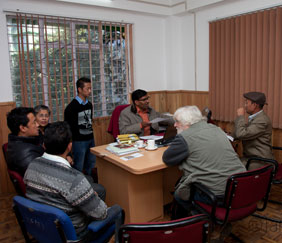
Conveniently, the directorate for the Himalayan Zoological Park is housed in the same building as the Forests, Environment and Wildlife Management Department in Deorali. Everyone made us feel very welcome and always would make time to see us despite their own hectic schedules.
|
|
|
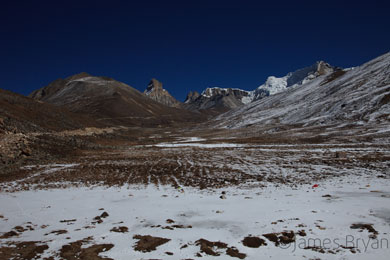
Into the Realm of the Snow Leopard
Naturally, any visit to Sikkim would be incomplete without a brief foray above the tree line to where the snow leopard reigns. Here we are at 4,800m (15,750ft). The dark brown just beyond the snow in the foreground is alpine vegetation and grazing for the vast numbers of blue sheep that live in these high plateaux. Blue sheep - a key prey species of the snow leopard - have thrived in the protected snow leopard habitat in Sikkim, particularly since the restriction on grazing domestic livestock such as yak and dzo, although there are still some owned by nomadic herders in the area (S. Sathyakumar, et al., April 2008 - May 2010). We also saw evidence that wild yak are grazing these areas, and although a snow leopard will avoid confronting a fully-grown yak, their young calves would present a potential food source.
Critically, because of the relatively low number of people in Sikkim and the fact that the terrain is so unforgiving, human development and areas of dense habitation are largely restricted to lower altitudes. This naturally reduces the risk of conflict or poaching.
In the initial stages of the proposed work, camera trapping, DNA analysis and other techniques will be utilised to study the current existence of snow leopard and other cat and their prey species in Sikkim. In addition, the evaluation of data throughout the adjoining regions of Nepal, China, Tibet and Bhutan, will confirm where snow leopard populations have been depleted or decimated. This will identify the best areas for our pilot scheme to strengthen numbers or reintroduce snow leopard where a need has been identified.
|
|
Camera Trapping
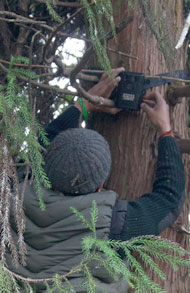 Here's one of the
Here's one of the zoo staff setting up a camera trap inside the Himalayan Zoological Park.
We know that wild cats such as clouded leopard and leopard cat frequently visit the zoo, along with barking deer, Himalayan black bear, jackal, langur and many other mammals, but no one has yet provided any photographic proof. Now, thanks to the Cat Survival Trust, the zoo has 4 strategically-placed camera traps on their 568 acre site, which are in the capable hands of their keepers. We've also supplied them with a shiny new laptop to upload pictures of any interesting animals they happen to capture.
We shall continue to bring you updates and photographs from our camera traps in Sikkim as we are given the data. Please ensure you follow our Facebook feed for all the latest news.
|
|
|
Meeting Room Progress
Thank you for the overwhelming response to our appeal in the last edition. We are pleased to report that real progress has been made in the meeting room and members' facilities: The floors have been screeded throughout, there is a very posh suspended ceiling and recessed lighting, the walls have been plastered, and we have a temporary wood-burner providing some much-needed heat.
We have purchased a wood-burning oven (perfect for pizzas!) to go in the new kitchen area and, due to the unfortunate demise of Comet electricals, we have been able to pick up the rest of the appliances for an absolute bargain.

There is still much to be done, and funds are still desperately needed for this and other projects here in Welwyn and also for the work that we are doing in India and Argentina. We are not a wealthy charity. We do not have expensive head offices or indeed any paid staff, so you can be assured that we really are making every penny of your hard-earned money count; doing things that really will make a difference. So please take a moment to visit our donation page to see how you can help us.
Thank you from us all at the Cat Survival Trust and have a very happy Christmas and peaceful New Year.
|
|
A New Arrival!
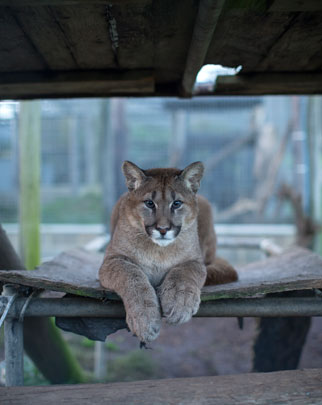 Meet Toffee, our new male puma! He arrived as a nervous 6 month old from Exmoor Zoo, where he was born in March. He was kept in the inside quarters at first to get him used to the environment and the scent of the two ladies he would be sharing a home with, but finally after a couple weeks was introduced to our mother and daughter Pumas without any fuss, but with a lot of nervousness from the on site staff. Terry, on the other hand, was always confident he would be perfectly fine and as always Dr. Moore was right. He has kept himself to himself for now but does come out into the enclosure with the ladies and his confidence is growing day by day. We are very hopeful that one day he will father kittens. Yes, kittens - puma are classed as a lesser cat and so their young are not called cubs. We don't think of them as "lesser" in any way, though!
|
|
|
|
|
|
|